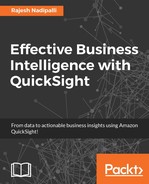QuickSight is a new AWS service and was launched in November 2016. While the product is revolutionary and has a bold vision, there are several shortcomings with the current version for it to replace enterprise BI solutions. In this chapter, we will review the following:
- A recap of the key product features
- Features lacking and what is in the roadmap
- User guide and community forum
QuickSight is designed to make analysis easy for all employees within an organization - with interactive visualizations, ad hoc analysis, and the ability to query data from most AWS data sources. Let's review the key features of the product; I have grouped them into the following categories:
- Visualizations and ad hoc analysis
- Data connectivity
- Data preparation
- Sharing and access
- User management
- Operations
QuickSight's primary objective is to provide cloud-powered business analytics as a service for everyday analysis. Here are the key features in this category:
- Ease of use: QuickSight empowers people from all roles in an organization to easily explore their data from any source and visualization for your data without any IT involvement
- Wide variety of visualizations: QuickSight supports bar charts, line graphs, area line charts, scatter plots, heat maps, pie graphs, tree maps, and pivot tables
- Smart visualizations: QuickSight comes with an autograph feature that automatically infers data type and provides suggestions for best possible visualizations
The following screenshot shows a QuickSight dashboard, which is a convenient way to share an analysis with others:

Figure 8.1: QuickSight visuals
In this section, we will review QuickSight's features for data connectivity:
- Deep integration with AWS sources: QuickSight can connect to several AWS data sources, including EMR, RDS, DynamoDB, Redshift, Kinesis, Athena, and S3. QuickSight seamlessly discovers the data sources that are available in your account.
- Self service ingestion: QuickSight allows you to upload your data using Excel, CSV, TSV, CLF, and ELF. You can also import data from SaaS applications such as Salesforce.
- Source from on-premises databases: QuickSight can connect to on-premises databases such as SQL Server, MySQL, and PostgreSQL.
The following screenshot shows different data sources supported by the current version of QuickSight:

Figure 8.2: Datasets
For scenarios where your data is not clean and/or needs to be joined with reference data before it is used, QuickSight can help. Let's review these data preparation features:
- Functions: QuickSight supports various functions to format and transform your data. You can change data types and use one of many string, date, numeric, and conditional functions before it is visualized.
- Joins: QuickSight also supports join operations using a simple drag and drop interface.
- Blazing fast performance: QuickSight is powered by SPICE, a super fast calculation engine that delivers unprecedented performance of these transformations at big data scale as it caches data in memory in distributed mode.
In this section, we will review the features to share and collaborate analysis:
- Collaborate, share, and publish: You can share your live analyses, read-only dashboards, and storyboards with any number of recipients using e-mail addresses, usernames, or a group name. You can also control the permission level before sharing content with others.
- Mobile and web access: All analyses, dashboards, and stories can be accessed on any device supporting a web browser and native applications for iPads and iPhones.
In this section, we will review the features related to security:
- User management: You can manage up to 100 user accounts in the standard edition, and an unlimited number if you go for enterprise edition AD accounts. Users can be added with just an e-mail address or using the IAM account.
- Managing QuickSight access: You can control the permissions given to QuickSight to access your AWS resources with an account that has QuickSight administration privileges.
The following screenshot shows how to manage access to QuickSight from the various data sources:

Figure 8.3: Security and access
QuickSight is a fully managed cloud BI service with no hardware or software to license. Let's review the key features related to hosting and operations:
- Cost effective: QuickSight is priced at $9 per user per month (for the Standard edition) and is a complete managed service which eliminates the need for software installation and maintenance. The following table provides details on pricing and tiers:
Free tier
Standard edition
Enterprise edition
Price per user per month
$0
$9 (annual commitment) / $12 (no commitment)
$18 (annual commitment) / $24 (no commitment)
SPICE capacity (GB/user)
1 GB
10 GB
10 GB
Additional GB cost per month
$0.25
$0.25
$0.38
- Zero infrastructure management: QuickSight just requires a web browser and also works great on mobile devices. It does not require any hardware or software to manage and does not require additional licenses.
That completes the high-level feature overview of AWS QuickSight; next we will look into what features it lacks.
